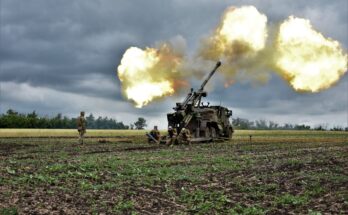A snapshot of recent news from sources around the world on the ongoing Russia-Ukraine war.

Political Developments
President Joe Biden signed a bill banning imports of enriched uranium from Russia. The U.S. spends around $1 billion annually on Russian nuclear fuel, meaning the ban will cut off this supply of revenue to Moscow that could be used to sustain its invasion of Ukraine.
U.S. Secretary of State Antony Blinken traveled to Kyiv this week. He noted in a statement that Russia is preparing a new offensive targeting Kharkiv, highlighting Russia’s use of North Korean artillery, Iranian drones, and Chinese military components.
“We are with you today. And we will stay by your side until Ukraine’s security, sovereignty, its ability to choose its own path is guaranteed.” – U.S. Secretary of State Antony Blinken
Estonia is considering the possibility of sending troops to western Ukraine to serve in non-combat roles, which could free up Ukrainian soldiers to move to the front lines. The concept has been floated among NATO allies in the past, and there is currently no formal to move forward with such troop deployments.
On the subject of deploying troops to Ukraine, Swedish Defense Minister Pal Jonson said, “There’s no concrete proposal for it here and now. If it comes up, a concrete proposal, we can take it into review.”
Ukraine is pushing for the U.S. to lift its ban on using donated American weapons to strike targets inside of Russia, including Russian troops gathering along the border ahead of offensive maneuvers. The ban is a result of the Biden administration wanting to avoid escalating tensions between the U.S. and Moscow. The fear of escalation is also why it took so long for the U.S. to donate Army Tactical Missile Systems to Ukraine, as those missiles would be able to reach Russia.
Ukrainian Defense Minister Rustem Umerov dismissed Serhii Baranov, who previously headed the Missile, Artillery, and UAV Forces, according to an announcement on May 14.
Russian President Vladimir Putin replaced Defense Minister Sergei Shoigu over the weekend, announcing economist Andrey Belousov as his successor. Shoigu will become the head of the Russian Security Council — displacing Putin confidante Nikolai Patrushev — and oversee Russian arms export policy. The shuffle at the Defense Ministry’s leadership is seen as an effort to improve efficiency in defense procurement and crack down on corruption.
Military Assistance to Ukraine
During his visit to Ukraine, Secretary of State Antony Blinken announced $2 billion in Forieing Military Financing for Kyiv, which will be funded via the $60 billion military and economic aid package passed by Congress in April. The $2 billion FMF package, which is the largest ever given to Ukraine, will be used to help Ukraine grow its defense industrial base.
Germany plans to buy three HIMARS rocket launchers from the U.S. inventory and donate them to Ukraine, according to German Defense Minister Boris Pistorius. The move was initially put in place to bypass a stalled U.S. military aid bill that was stuck in Congress. U.S. lawmakers eventually passed the aid legislation, which would allow the U.S. to donate the launchers without using a loophole with Germany. Nevertheless, Germany said it would still move ahead with the HIMARS donation plan, which will cost Berlin around $30 million.
Italy may donate a second SAMP/T air defense battery to Ukraine. A decision will reportedly be made within the next two weeks. The battery, one of five in service with Italy after an initial system was donated earlier, is currently based in Kuwait. The SAMP/T is a tactical missile defense system mounted on a truck.
Denmark said on Thursday it would provide another EUR750 million in military assistance to Ukraine. Foreign Minister Lars Løkke Rasmussen said the aid would bolster Ukraine’s air-defense and artillery capabilities.
A group of U.S. lawmakers are urging the Department of Defense to send more small, American-made drones to Ukraine. The group points out that most of the small drones being used by Ukrainian forces are sourced from China.
Battlefield Updates
Recent reports indicate a surge in tensions on Ukraine’s northern front, following a breach of Ukraine’s defense line by Russian forces on May 10. Ukrainian officials caution that although the situation is not yet labeled as “significant,” there has been an unexpected escalation in ground combat in the region.
“The Russian shelling is not stopping, threats persist,” Ukrainian President Volodymyr Zelensky said during a visit to the key industrial city of Kharkiv this week, which is believed to be the target of Russia’s upcoming military offensive.
Putin asserted that Moscow is not after the capture of Kharkiv, but instead seeking to create a buffer zone from its territory. State media RIA Novosti, meanwhile, reported that Russian troops are attempting to capture the village of Lyptsi, located 30 kilometers north of the Kharkiv.
Ukraine conducted strikes on Belbek airbase in Sevastopol this week, seemingly destroying or severely damaging three Russian combat aircraft stationed at the base.
Ukraine is struggling to intercept Russian missile and drone attacks as Moscow continues to put pressure on the country’s overburdened air defense systems. Ukraine has called on Western allies to provide more air defense capabilities, but Russia has also shifted tactics to make it more difficult for Ukraine to intercept its weapons, including firing larger barrages.
A new report claims that Ukraine’s air defense network is slowly deteriorating. Kyiv is facing shortages of ammunition. Ukraine intercepted only 46 percent of Russian missiles over the past six months. In the previous six months the intercept rate was 73 percent.
The surge of attack drones on the battlefield has resulted in both Ukrainian and Russian forces adopting new protection measures for their tank fleets. The U.S. reportedly requested that Abrams tanks donated to Ukraine avoid the front lines because of the growing threat. Tanks have adopted various types of new and improvised armor intended to take the brunt of a drone’s warhead before impacting the tank itself. Electronic warfare systems are also being outfitted on tanks to disrupt incoming attack drones.
Further afield, Ukrainian drones struck an oil refinery in Krasnodar Krai overnight on May 17. Russia claimed to have downed dozens of drones in the region, but numerous videos showed a fire in the oil refinery located in Tuapse.
For 50 years, Forecast International intelligence reports have been the aerospace and defense industry standard for accurate research, analysis, and projections. Our experienced analysts compile, evaluate, and present accurate data for decision makers. FI's market research reports offer concise analysis of individual programs and identify market opportunities. Each report includes a program overview, detailed statistics, recent developments and a competitive analysis, culminating in production forecasts spanning 10 or 15 years. Let our market intelligence reports be a key part of reducing uncertainties and mastering your specific market and its growth potential. Find out more at www.forecastinternational.com



